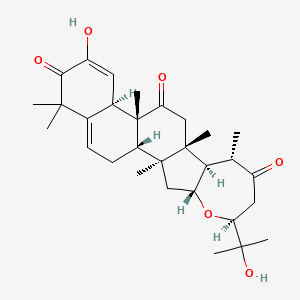| Authors | Title | Published | Journal | PubMed Link |
|---|---|---|---|---|
| Maloney KN et al. | Actin-aggregating cucurbitacins from Physocarpus capitatus. | 2008 | J. Nat. Prod. | pmid:18959442 |
| Pan L et al. | Isolation, structure elucidation, and biological evaluation of 16,23-epoxycucurbitacin constituents from Eleaocarpus chinensis. | 2012 | J. Nat. Prod. | pmid:22239601 |
| Escandell JM et al. | Cucurbitacin R reduces the inflammation and bone damage associated with adjuvant arthritis in lewis rats by suppression of tumor necrosis factor-alpha in T lymphocytes and macrophages. | 2007 | J. Pharmacol. Exp. Ther. | pmid:17065367 |
| Abou-Khalil R et al. | Interaction of cucurbitacins with human serum albumin: Thermodynamic characteristics and influence on the binding of site specific ligands. | 2009 | J. Photochem. Photobiol. B, Biol. | pmid:19380237 |
| Chaves DC et al. | Cucurbitacins from Cayaponia racemosa: isolation and total assignment of 1H and 13C NMR spectra. | 2007 | Magn Reson Chem | pmid:17372957 |
| Seger C et al. | 1H and 13C NMR signal assignment of cucurbitacin derivatives from Citrullus colocynthis (L.) Schrader and Ecballium elaterium L. (Cucurbitaceae). | 2005 | Magn Reson Chem | pmid:15772995 |
| Rao VS et al. | Evaluation of the purified fraction of Wilbrandia (c.f.) verticillata for antitumour activity. | 1991 | Mem. Inst. Oswaldo Cruz | pmid:1842011 |
| Gillespie JJ et al. | Convergent evolution of cucurbitacin feeding in spatially isolated rootworm taxa (Coleoptera: Chrysomelidae; Galerucinae, Luperini). | 2003 | Mol. Phylogenet. Evol. | pmid:12967617 |
| Chawech R et al. | Cucurbitacins from the Leaves of Citrullus colocynthis (L.) Schrad. | 2015 | Molecules | pmid:26437392 |
| Nayab D et al. | Cucurbitacin glucosides from Citrullus colocynthis. | 2006 | Nat. Prod. Res. | pmid:16644537 |
Cucurbitacin S
Cucurbitacin s is a lipid of Sterol Lipids (ST) class. The involved functions are known as establishment and maintenance of localization and nitric oxide biosynthetic process.
Cross Reference
Introduction
To understand associated biological information of Cucurbitacin S, we collected biological information of abnormalities, associated pathways, cellular/molecular locations, biological functions, related genes/proteins, lipids and common seen animal/experimental models with organized paragraphs from literatures.
What diseases are associated with Cucurbitacin S?
There are no associated biomedical information in the current reference collection.
No disease MeSH terms mapped to the current reference collection.
PubChem Associated disorders and diseases
What pathways are associated with Cucurbitacin S
There are no associated biomedical information in the current reference collection.
PubChem Biomolecular Interactions and Pathways
Link to PubChem Biomolecular Interactions and PathwaysWhat cellular locations are associated with Cucurbitacin S?
There are no associated biomedical information in the current reference collection.
What functions are associated with Cucurbitacin S?
Related references are published most in these journals:
| Function | Cross reference | Weighted score | Related literatures |
|---|
What lipids are associated with Cucurbitacin S?
There are no associated biomedical information in the current reference collection.
What genes are associated with Cucurbitacin S?
There are no associated biomedical information in the current reference collection.
What common seen animal models are associated with Cucurbitacin S?
There are no associated biomedical information in the current reference collection.
